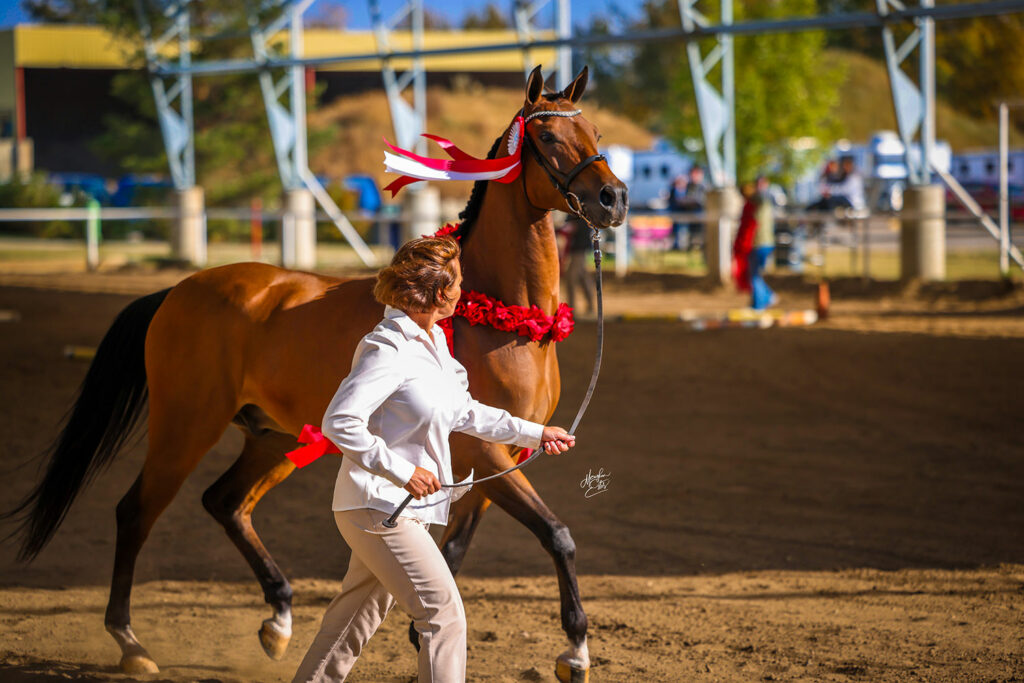By: Scott Benjamin
The Arabian horse is celebrated as one of the oldest equine breeds, with origins tracing back nearly 5000 years. Nurtured in the harsh environment of the Arabian Peninsula, from which the breed takes its name, the earliest ancestors were domesticated by the Bedouin. These nomadic tribes, who made a living as tradesmen along the ancient silk and spice routes connecting East with West, elevated their status to celebrated warriors with the arrival of their Arabian horse. Swift, intelligent, surefooted, and courageous, the Arabian horse became the preferred mode of transportation for ceremony, contest, and warfare for these tenacious and ambitious peoples, not to mention the most prized earthly possession from which great status and wealth were derived in their hierarchical culture.
Selected over centuries by both man and nature, the Arabian horse was very much a product of its environment – the dry hostile desert of the Nejd, with its temperature extremes, lack of quality sustenance and vast distances of rugged hostile terrain. Survival in this unforgiving region required a horse that: had black skin with great vascularity able to withstand the sun and dissipate heat; a fine, tightly packed, lustrously oily coat to insulate against the dust and night cold; large capacious nostrils to maximize air intake and oxygenate the blood; broad, rugged hooves to navigate the challenging terrain; and incredibly strong, dense, compact bone to withstand the distances and concussion of life in the desert. Furthermore, the Bedouin needed a well-balanced, strongly coupled mount replete with speed, agility, and stamina, which resulted in a horse of moderate size and substance that possessed unparalleled resilience. The highly carried forehand and tail, for which the breed is still universally renowned, were further developed over the centuries, the former trait to allow for greater manoeuvrability in warfare, and the latter for maximised heat dispersion during intense exertion.

BL Reigning Fire owned by Marilyn Robinson with handler Brenda Dreidiger by Meaghan Estes
The transient lifestyle of the Bedouin also required a horse of uncommon intelligence, keen natural instincts, and an inherent affinity for human interaction, all of which made the intimate existence of the Arabian horse and their devoted caretakers one of the most consequential, and mutually beneficial, in all human history. This combination of characteristics, both physiological and psychological, are fundamental to the essence of Arabian type according to the modern standard, an archetype based on the ancient ideal that assured not only progress, but also survival, for both horse and human. Dispersed across North Africa and into Europe during the Islamic expansion of the Middle Ages, the Arabian horse became an object of great desire by both the nobility and militaries throughout the Romantic Period, when the establishment of breeds for all domesticated species of animals became a serious pursuit. Royal, aristocratic, and national studs devoted to the breeding of Arabian horses, both as purebreds and as essential outcrosses for other light horse breeds, were established across Europe, most notably in Poland, Russia, Germany, Spain, France, Hungary, and Great Britain. The most influential collection of purebred Arabians to leave the Arabian homeland were those exported to England by Sir Wilfrid and Lady Anne Blunt for the Crabbet Park in the mid to late 19th century. The blood of these horses can still be found on every continent on which the Arabian horse thrives today, including in the most successful breeding programmes that now dominate the Middle East.
The diaspora of the breed during the age of colonialism has resulted made the Arabian horse an essential ancestor in the formation of nearly every light horse breed on the planet. The influence of the Arabian horse on the origin of the Thoroughbred is legendary, with both the Godolphin and Darley Arabian esteemed as two of the three most important foundation sires. Immensely popular breeds such as the American Quarter Horse, the Morgan, the American Saddlebred, Lipizzaner, the Australian Stockhorse and nearly every breed of European Warmblood owe their origins to Arabian ancestors, as do a larger number of pony and draft horse breeds such as the Welsh, German Riding Pony, Pony of the Americas, Percheron and Haflinger. Popularity and awareness for the breed increased after the publication of Walter Farley’s immensely influential The Black Stallion series of books, a richly detailed and heartfelt saga that gained even greater global exposure with the release of three feature films based on the stories in 1979, 1983 and 2003.
The societal and ecological crucible in which the Arabian breed was forged has resulted in a horse unlike any other in our modern age. Universally renowned as the versatile breed, the Arabian horse can perform well across a greater range of equine sport and disciplines than any other equid. From working western and ranch work to show jumping and dressage, the Arabian horse can be found competing at all these disciplines and at everything in between, with skill, capability, and enthusiasm. Unsurprisingly, the Arabian horse is unrivalled in the discipline of endurance, an athletic pursuit for which the breed was carefully selected, both by man and nature, for millennia. The Arabian horse remains one of the most popular breeds in the world, and in a fitting tribute to its ancient status as one of the oldest equines, Arabians are utilised, enjoyed, and loved in more countries around the world than other horse breed ever to have existed.